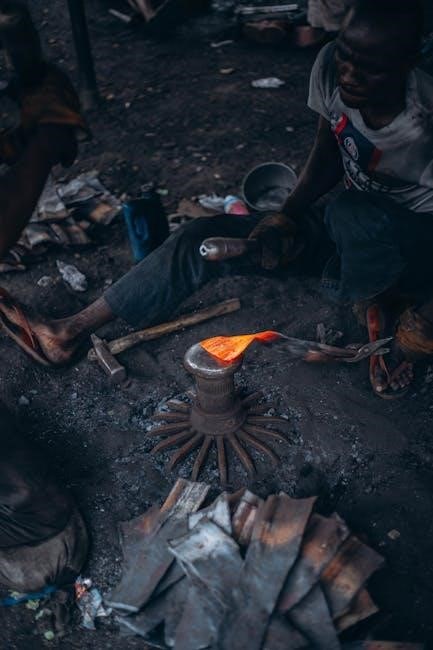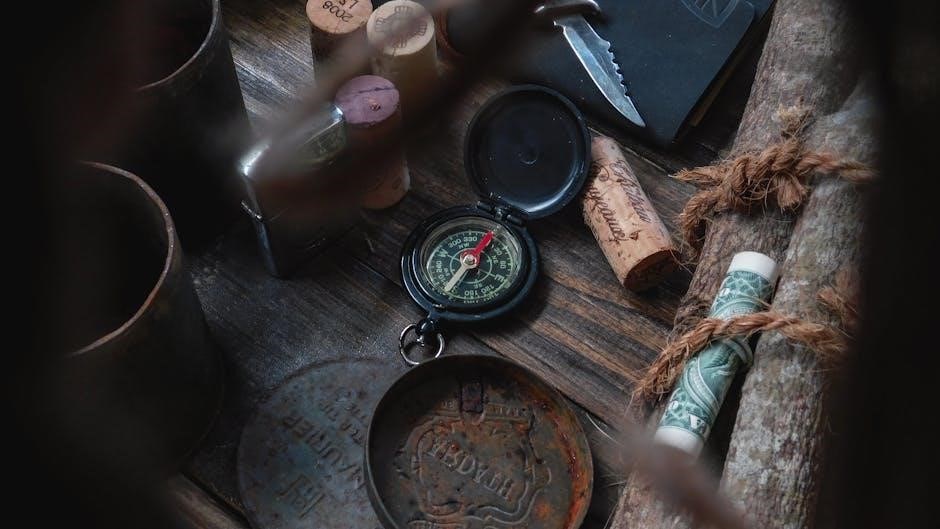Blacksmithing is a versatile crafting profession that involves shaping metal to create weapons‚ armor‚ and other essential items. It pairs perfectly with Mining‚ providing the necessary materials. This skill is crucial for equipping characters with high-quality gear‚ enhancing game progression. Whether crafting for personal use or selling on the market‚ blacksmithing offers both practicality and creativity. Mastering it requires understanding materials‚ recipes‚ and specializations to produce powerful gear efficiently.
What is Blacksmithing?
Blacksmithing is a crafting profession that involves working with metals and ores to create weapons‚ armor‚ and other equipment. It requires a forge and anvil to shape raw materials into functional items. This skill is essential for equipping characters with gear that enhances their abilities. Blacksmiths can specialize in either Armorsmith or Weaponsmith‚ focusing on crafting armor or weapons‚ respectively. The profession relies heavily on materials gathered through Mining or purchased from vendors. As players progress‚ they unlock advanced recipes‚ allowing the creation of powerful gear. Blacksmithing is both a practical and profitable skill‚ enabling players to craft items for personal use or sell them on the in-game market. It plays a key role in character progression and the game’s economy.
Importance of Blacksmithing in Game Progression
Blacksmithing is a cornerstone profession in game progression‚ enabling players to craft essential weapons and armor that enhance character performance. By creating high-quality gear‚ blacksmiths can improve their own and others’ abilities‚ making it easier to defeat enemies and complete challenging content. This profession also supports other crafting skills‚ such as Mining‚ by providing a use for mined ores and bars. Additionally‚ blacksmithing allows players to craft items for sale‚ contributing to the in-game economy. As characters progress‚ the demand for superior gear increases‚ making blacksmithing a vital skill for both personal advancement and supporting allies. Its influence extends to endgame content‚ where crafted items often serve as stepping stones for acquiring powerful equipment.
Benefits of Leveling Blacksmithing
Leveling blacksmithing unlocks the ability to craft high-quality weapons and armor‚ significantly enhancing your character’s performance in combat. As you progress‚ you gain access to rare and powerful recipes‚ allowing you to create gear that is often superior to what can be found through loot. This not only strengthens your character but also enables you to craft items for other players‚ generating gold through sales in the in-game market. Additionally‚ blacksmithing complements the Mining profession‚ providing a practical use for mined ores and bars. By mastering this skill‚ you become self-sufficient in equipping yourself and your allies‚ while also contributing to the game’s economy. The rewards of blacksmithing grow exponentially with each level‚ making it a valuable investment for any player.

Getting Started with Blacksmithing
To begin‚ you’ll need basic tools like a blacksmith hammer‚ anvil‚ forge‚ tongs‚ and slack tub. Find a blacksmithing trainer in major cities like Stormwind or Orgrimmar.
Finding a Blacksmithing Trainer
To learn blacksmithing‚ you must first find a trainer. Trainers are located in major cities like Stormwind‚ Orgrimmar‚ Ironforge‚ and Undercity. Each city has a blacksmithing trainer catering to specific races. For example‚ Stormwind trainers serve humans‚ while Orgrimmar trainers serve orcs and trolls. To locate a trainer‚ ask a city guard for directions or check near the city’s forge or crafting district. Trainers offer apprentice and journeyman training‚ which are essential for progressing your skill. Regularly visiting trainers as you level up ensures you unlock new recipes and techniques. Remember‚ trainers are hubs for skill advancement‚ so they’re a crucial part of your blacksmithing journey.
Trainer Locations in Major Cities
Trainers for blacksmithing are conveniently located in major cities across Azeroth. In Stormwind‚ find the trainer near the city’s forge‚ while Orgrimmar’s trainer is situated close to the horde’s main crafting area. Ironforge’s trainer is within the dwarven city’s bustling crafting district‚ and Undercity’s trainer lies in the undead capital’s industrial section. For night elves‚ the trainer is in Darnassus’ artisans’ enclave‚ and tauren can locate theirs in Thunder Bluff’s central hub. Each city’s trainer is easily accessible‚ ensuring players can quickly begin or advance their blacksmithing journey. These trainers provide essential training‚ enabling players to unlock new recipes and enhance their crafting skills efficiently.
Initial Tools and Equipment Needed
To begin blacksmithing‚ you’ll need basic tools and equipment. A forge is essential for heating metals‚ and an anvil is required for shaping them. Tongs are necessary for handling hot materials safely. Additionally‚ a slack tub is needed to quench items‚ helping achieve the desired properties. While these are the minimum requirements‚ having a blacksmith hammer and proper workspace can significantly improve efficiency. For crafting‚ ensure you have access to a forge and anvil‚ as they are fundamental to the blacksmithing process. These tools can be purchased or crafted‚ depending on your resources. Starting with the basics allows you to begin crafting simple items and progress in the profession effectively.

Understanding Blacksmithing Specializations
Blacksmithing offers two specializations: Armorsmith and Weaponsmith. Armorsmiths craft armor‚ while Weaponsmiths focus on weapons. Each specialization enhances your ability to create specific gear‚ aiding progression.
Types of Specializations (Armorsmith vs. Weaponsmith)
Blacksmithing specializations allow players to focus on crafting either armor or weapons. Armorsmiths specialize in creating plate armor‚ which is ideal for classes like Warriors and Paladins. Weaponsmiths focus on crafting weapons‚ such as swords‚ axes‚ and maces‚ benefiting melee DPS classes like Rogues and Warriors. Each specialization offers unique recipes and requires specific materials. Choosing between Armorsmith and Weaponsmith depends on your character’s needs and playstyle. For example‚ tank characters may benefit more from Armorsmith‚ while DPS-focused characters may prefer Weaponsmith. Specializing early can enhance your crafting efficiency and help you progress faster in the game. Both paths require dedication and resource management to master.
Choosing the Right Specialization for Your Needs
Choosing between Armorsmith and Weaponsmith depends on your character’s role and goals. Armorsmith is ideal for players focusing on tanking or classes requiring heavy armor‚ such as Warriors and Paladins. Weaponsmith suits melee DPS classes like Rogues or Hunters needing high-quality weapons. Consider your endgame objectives: crafting gear for yourself‚ your guild‚ or selling on the market. Material availability and personal preference also play a role. If you plan to craft for multiple classes‚ Armorsmith offers more versatility. For weapon-focused characters‚ Weaponsmith provides superior options. Ultimately‚ align your specialization with your playstyle and progression needs to maximize efficiency and resource use.
Pros and Cons of Each Specialization
Armorsmith specializes in crafting plate armor‚ offering exceptional protection for tanking classes like Warriors and Paladins. It provides versatile gear for multiple class needs but may require more materials. Weaponsmith focuses on creating powerful weapons‚ ideal for melee DPS classes like Rogues and Hunters‚ but lacks armor crafting versatility. Armorsmith is beneficial for guilds needing armor sets‚ while Weaponsmith excels in producing high-demand weapons. Consider your character’s role and market demand when choosing. Armorsmith offers more flexibility‚ while Weaponsmith delivers focused weapon upgrades. Both require significant resources‚ so align your choice with long-term goals and playstyle to optimize results.

Materials and Crafting
Blacksmithing requires various ores and metals‚ obtained through mining or purchased from vendors. These materials are crafted into essential items like weapons and armor.
Required Materials for Blacksmithing
Blacksmithing requires a variety of ores and metals‚ such as Copper‚ Tin‚ Iron‚ and Steel‚ which are primarily obtained through mining or purchased from vendors. These materials are essential for crafting weapons‚ armor‚ and other items. Early levels rely heavily on stones like Rough Stone and Coarse Stone‚ which are cheap and abundant. As you progress‚ you’ll need rarer ores like Mithril and Thorium for advanced recipes. Coal is also crucial for fueling the forge‚ especially when crafting Steel Bars. Managing these resources effectively ensures consistent progression and minimizes delays. Players often pair Blacksmithing with Mining to sustainably gather materials‚ reducing reliance on the market. Proper material management is key to efficient crafting and leveling.
Where to Find Materials (Mining‚ Vendors‚ etc.)
Mining is the primary method for obtaining ores like Copper‚ Tin‚ and Iron‚ which are abundant in mineral-rich zones. Vendors‚ particularly Blacksmithing Supply vendors near trainers‚ sell essential materials like Coal. Golden Rods‚ crafted from Copper Bars‚ are also valuable for Enchanters. Players can purchase materials from the auction house or directly from other players. Additionally‚ some ores and stones can be found in loot or as quest rewards. Efficiently gathering materials ensures consistent progression and minimizes delays. Pairing Blacksmithing with Mining allows for sustainable resource collection‚ reducing reliance on vendors. Managing these sources effectively helps maintain crafting efficiency and keeps costs low‚ especially during early leveling phases.
Crafting Recipes and Their Importance
Crafting recipes are the backbone of blacksmithing‚ enabling the creation of essential weapons‚ armor‚ and tools. Each recipe serves a specific purpose‚ from early-game items like Copper Weapons to advanced gear for high-level characters. Recipes guide material usage‚ ensuring efficient crafting and skill progression. They often become available as you level up or through specialized trainers. Rare and vendor-exclusive recipes unlock unique items‚ enhancing gameplay and character effectiveness. Prioritizing the right recipes at each skill level minimizes material waste and accelerates progression. Exploring and mastering these recipes is crucial for maximizing your blacksmithing potential and crafting high-demand gear for personal use or sale.

Leveling Your Blacksmithing Skill
Mastering blacksmithing requires strategic progression‚ utilizing materials efficiently‚ and following expert guides. Trainers in major cities help unlock new recipes‚ while mining provides essential resources. Crafting the right items at each skill level ensures steady progression from 1 to 300‚ enabling the creation of powerful gear and weapons for both personal use and trade.
Leveling from 1-75: Early-Game Strategies
Starting your blacksmithing journey‚ focus on crafting items that provide the highest skill gains. Begin with Rough Stone and Coarse Stone recipes‚ such as Stone Hammer and Rough Bludgeoner‚ which are efficient for early leveling. These materials are inexpensive and readily available through mining or vendors. As you progress‚ switch to Copper Bars for crafting Coarse Cleaver and Stone Axe‚ ensuring steady skill increases. Keep crafting until recipes turn green to maximize efficiency. Selling unused items can help fund your crafting journey. By following this strategy‚ you’ll quickly reach level 75‚ setting a strong foundation for advanced blacksmithing.
Leveling from 75-150: Mid-Game Recipes and Techniques

At this stage‚ focus on crafting mid-tier items using bronze and steel materials for consistent skill gains. Recipes like Bronze Axe and Steel Plate Belt are highly efficient. Prioritize crafting patterns that remain yellow or orange‚ as these provide the best experience. Utilize Golden Rods for additional skill-ups if needed. Keep an eye on recipe colors‚ as green recipes no longer provide skill gains. This phase is crucial for refining your crafting technique and preparing for advanced recipes. Selling surplus items can help offset material costs. By leveraging these strategies‚ you’ll efficiently progress from 75 to 150‚ unlocking more complex crafting opportunities.
Leveling from 150-225: Advanced Crafting
At this stage‚ focus on crafting high-tier items using Truesilver and Arcanite for significant skill gains. Recipes like Truesilver Gauntlets and Arcanite Reaper are highly effective. These items are in high demand due to their powerful stats‚ making them valuable to craft or sell. Optimize material usage by crafting in bulk and using leftover materials for smaller projects. Specialization into Armorsmith or Weaponsmith becomes critical‚ as it unlocks advanced recipes tailored to your playstyle. This phase refines your crafting efficiency and prepares you for endgame content. Consistent crafting and smart material management are key to reaching 225 and becoming a master blacksmith.
Leveling from 225-300: Endgame Crafting and Specialization
Reaching the endgame‚ blacksmithing focuses on crafting high-tier gear and weapons using rare materials like Arcanite Bars and Enchanted Thorium. Specialization into Armorsmith or Weaponsmith is crucial‚ as it unlocks advanced recipes for powerful items. Armorsmiths can craft elite plate armor‚ while Weaponsmiths focus on high-damage weapons. Both paths require significant material investments but yield gear highly sought after for raids and PvP. Rare patterns and reputation-based recipes further enhance your crafting capabilities. Efficiency is key‚ as crafting these items can be costly. This phase solidifies your reputation as a master blacksmith‚ enabling you to create gear that stands out in the endgame environment.

Maximizing Efficiency
Optimize crafting routes‚ manage resources effectively‚ and use addons or tools to streamline your blacksmithing process. This ensures minimal waste and faster progression through the levels.
Optimizing Crafting Routes and Patterns
Optimizing crafting routes and patterns is crucial for efficient blacksmithing. Start with early materials like Rough Stones‚ which are cheap and plentiful‚ to quickly gain initial levels. Transition to Coarse Stones and Copper Bars as you progress‚ ensuring minimal waste. Plan your crafting sequence to align with skill level increases‚ using recipes that remain yellow for as long as possible. For higher levels‚ focus on Steel Bars and advanced patterns. Specialize in either Armorsmith or Weaponsmith to streamline your crafting path. Sell surplus items like Golden Rods to Enchanters to fund your progress. Always consult detailed guides or addons to stay updated with the most efficient routes and patterns‚ as the meta can shift with game updates. This strategic approach ensures you level quickly and cost-effectively.
Managing Resources Effectively
Managing resources efficiently is key to successful blacksmithing. Pair the profession with Mining to gather metals like copper and iron‚ reducing reliance on vendors. Use Coal‚ purchasable from blacksmithing suppliers‚ to craft Steel Bars‚ essential for higher-level items. Sell surplus materials‚ such as Golden Rods‚ to Enchanters to fund your crafting. Prioritize crafting recipes that use readily available materials‚ like Rough Stones for early levels and Coarse Stones as you progress. Transition to Copper Bars and Steel Bars for mid-to-high-level crafting. Plan your material usage to minimize waste and ensure a steady supply. Utilize addons or spreadsheets to track resource consumption and optimize your crafting schedule. This approach ensures you maintain a balanced inventory and avoid unnecessary expenses.
Using Addons or Tools for Efficiency
Using addons or tools significantly enhances blacksmithing efficiency. Addons like Auctionator simplify selling crafted items‚ while Gatherer helps track mining node locations for resource gathering. Spreadsheets and crafting planners enable optimal material usage and recipe selection. Websites like WoWhead provide detailed recipe lists and crafting routes. Addons such as “Crafting Planner” allow you to plan multiple crafts in advance‚ ensuring minimal material waste. Additionally‚ tools like “TradeSkillMaster” help manage inventory and automate crafting tasks. These resources streamline the leveling process‚ reduce costs‚ and save time‚ making it easier to reach max level. By leveraging these tools‚ you can focus on crafting efficiently and effectively‚ ensuring steady progress in your blacksmithing journey.

Endgame Blacksmithing
At endgame‚ blacksmithing focuses on crafting high-level gear and weapons‚ utilizing rare patterns and materials. Reputation with factions often unlocks special recipes‚ enhancing your crafting capabilities.
Crafting High-Level Gear and Weapons
Crafting high-level gear and weapons is a cornerstone of endgame blacksmithing‚ requiring rare materials and advanced recipes. These items often feature enhanced stats and unique properties‚ making them highly sought after by players. Many high-level patterns are obtained through reputation with specific factions or by completing challenging quests. For example‚ the “Lionheart Helm” and “Nightfall” recipes are only available after achieving revered status with certain vendors. Crafting these items not only boosts your reputation as a master blacksmith but also provides a competitive edge in raids and PvP. Additionally‚ some recipes can only be learned from rare drops or special events‚ adding an extra layer of difficulty and exclusivity to high-end crafting.
Special Recipes and Rare Patterns
Special recipes and rare patterns are highly sought after in blacksmithing‚ often requiring specific materials or achievements. These exclusive recipes can only be obtained through reputation rewards‚ rare drops‚ or completing challenging quests. For instance‚ the “Lionheart Helm” pattern is unlocked at revered reputation with the Argent Crusade‚ while “Nightfall” becomes available after earning exalted status with the Ebon Blade. Some patterns‚ like the “Stormforged Axe‚” are drops from raids or dungeons‚ adding rarity and value. Crafting these unique items not only showcases a blacksmith’s mastery but also provides powerful gear for endgame content. Players must actively seek out these rare patterns‚ making them a true testament to dedication and skill in the craft.
Reputation and Vendor Recipes
Reputation with various factions is crucial for unlocking exclusive blacksmithing recipes. Vendors associated with factions like the Argent Crusade‚ the Ebon Blade‚ and others sell rare patterns that enhance your crafting capabilities. For example‚ reaching “Revered” status with the Argent Crusade grants access to the “Lionheart Helm” recipe‚ while “Exalted” status with the Ebon Blade unlocks the “Nightforged Axe.” These recipes often require specific materials and are essential for crafting high-level gear. Building reputation not only expands your recipe library but also strengthens your ability to create powerful equipment for endgame content. Ensure you explore faction vendors regularly as you progress to discover these valuable patterns.

Additional Tips and Tricks
Staying organized‚ avoiding material shortages‚ and experimenting with new recipes can enhance your blacksmithing journey. Regularly check market prices and restock materials to stay efficient.
Common Mistakes to Avoid
One common mistake is neglecting to restock materials‚ leading to crafting interruptions. Crafting items that don’t align with your specialization can hinder progress. Overlooking skill-upgrading opportunities also slows leveling. Additionally‚ ignoring market trends when selling crafted items reduces potential profit. Always plan crafting routes and manage resources effectively to avoid setbacks. Regularly check trainer locations and update your recipes to stay on track. Avoiding these pitfalls ensures a smoother and more efficient blacksmithing experience‚ helping you reach max level faster and enjoy the game more fully.
Alternative Methods for Leveling
Exploring alternative methods can accelerate your blacksmithing progression. For instance‚ purchasing materials from vendors or other players can save time‚ especially if mining is inconvenient. Group crafting sessions allow sharing of resources and patterns‚ reducing individual costs. Additionally‚ farming specific nodes or mobs for rare materials can provide a steady supply. Experimenting with non-traditional recipes or specializing early in niche items can also offer unique advantages. Utilizing in-game addons to track market demand ensures you craft items that sell well‚ funding further progression. Finally‚ completing quests or faction reputations often rewards exclusive patterns‚ giving you an edge in leveling. These strategies diversify your approach and keep progression dynamic.

Staying Updated with Game Changes
Staying informed about game updates is crucial for optimal blacksmithing. Regularly check official patch notes for changes to recipes‚ materials‚ or crafting mechanics. Engage with online forums and communities to discuss new strategies and adaptations. Subscribe to professional guides and YouTube channels for updated tutorials and insights. Utilize in-game addons like TradeSkillMaster to track market trends and adjustments. Following developer blogs and attending live streams can also provide early insights into upcoming changes. By staying proactive‚ you ensure your blacksmithing skills remain relevant and efficient‚ adapting seamlessly to any game updates or expansions. This proactive approach keeps your crafting skills sharp and your progress uninterrupted.
